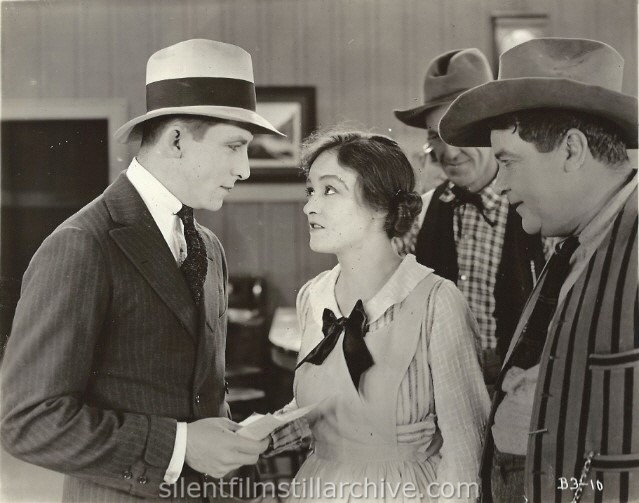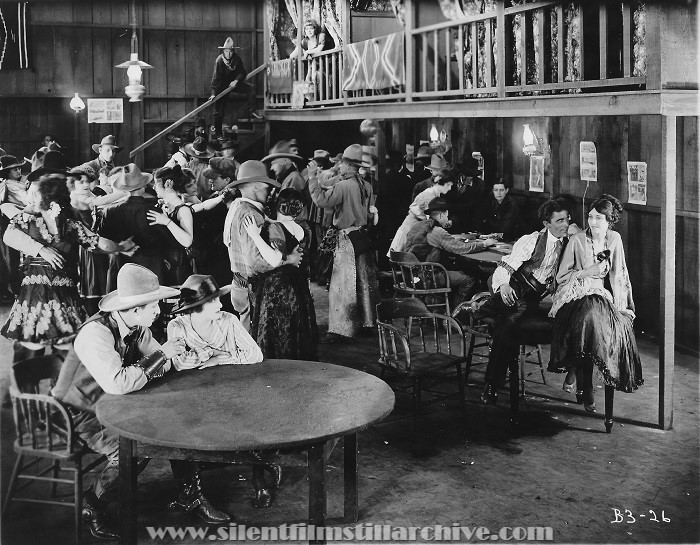![]()

Chasing Rainbows (1919)

B3-10 L to R: William Scott, Gladys Brockwell, unknown and Henry Dunkinson
This photo has some scratches on it, which can be seen on Brockwell's face. This photo is stamped "William Fox presents Gladys Brockwell in Chasing Rainbows, In which Beauty Conquers Lawless Men, Direction by Frank Beal, Victory Pictures, Fox Film Corporation."

B3-26 William Scott, Gladys Brockwell (left) and Walter Long and Irene Aldwyn (right)
CHASING RAINBOWS.
|
Sadie |
Gladys Brockwell |
|
Billy |
William Scott |
|
Skinny |
Richard Rosson |
|
Jerry |
Harry Dunkinson |
|
Allie |
Irene Aldwyn |
|
Lacy |
Walter Long |
|
Mrs. Walters |
Claire McDowell |
Producer, Fox Film Corp.; story Karl Harrman; scenario, R. A. Baldwin (Ruth Ann); direction Frank Beal; photographer, Friend H. Baker. Miss Brockwell is starred in this five-reeler scheduled for release on Nov. 2. The production is on the same par as all Fox-Brockwell yarns feature passably well. There is nothing startlingly new in either story, its treatment, locale, photography and enactment to place it above the usual standard.
Miss Brockwell as Sadie, a pie-slinger, is crossed in love, is transplanted to a new territory in a similar capacity, finds a husband and fade-outs at the end in the conventional "clinch." The support is worth. Abel
--Variety August 8, 1919, page 75.
Gladys Brockwell Goes to Arizona
Gladys Brockwell has gone to Tucson, Ariz. To make more Western scenes for her William Fox picture, "Chasing Rainbows" in which she enacts the breezy and slangy role of a chipper little waitress of a Western "has house."
--Moving Picture World, June 28, 1919, page 1692
DIGEST OF PICTURES OF THE WEEK
"CHASING RAINBOWS" (Fox) develops along the lines of the past Gladys Brockwell features. Again she is a working girl, and again something like the usual adventures occur to disturb the course of her life. It should do just about what her others have done for the box office and the entertainment of the public.
--Exhibitor's Herald, September 13, 1919, page 62
Surface "Movie" Stuff Makes Very Ordinary Program Offering
Gladys Brockwell in
"CHASING RAINBOWS"
Fox
DIRECTOR Frank Beal
AUTHOR Karl
Harriman
SCENARIO BY R. A. Baldwin
CAMERAMAN Friend H. Baker
AS A WHOLE Surface "movie" stuff of little worth; lacked
continuity of interest and several other important elements; ordinary
program offering.
STORY Largely a series of incidents; sometimes had a little
plot, but was very disjointedly arranged.
DIRECTION Never lifted matters out of the well-worn rut;
staged one fairly good fight.
PHOTOGRAPHY Varied from good to fair
LIGHTINGS Ordinary stuff
CAMERA WORK Nothing unusual
STAR Had a role that gave her lots of things to do; did them
well enough without being exceptional.
SUPPORT None of the players called on for much real work;
just went through their parts; cast included William Scott, Walter Long,
Irene Aldwyn, Richard Rosson, Claire McDowell and Harry Dunkinson.
EXTERIORS A few desert scenes; not of the exterior very
special.
INTERIORS Conventional and inexpensive
DETAIL Didn't figure very largely at any time
CHARACTER OF STORY Contained about everything used in
"movies".
LENGTH OF PRODUCTION 4,141 feet
"CHASING RAINBOWS" is very ordinary program stuff. For the most part the picture is made up of the soft of "movie" stuff that gets the go-by from present-day audiences. Folks aren't interested in motions pictures any longer just because they are a novelty, and a picture has to have some real reason and some real backbone before it gets by these days. And "Chasing Rainbows" hasn't got that all-important backbone. It is very flimsy affair, loosely constructed, and without any real reason to extenuate for its screening.
In the first place the film lacks continuity of interest. This is mainly due to the face that those responsible for the production tried to drag in about everything they could think of to save the day. Extraneous matter having no actual bearing on the main line of action often were dragged in by the heels, dropped when their present usefulness had ceased, and then picked up again when needed.
The story, instead of steadily building up to any certain point, kept shooting off at angles every once in a while, and then coming back to the main line whenever it pleased. And despite an early dragginess, a lot of ground was covered-rather skimmed over than covered, though. The picture was elemental in the extreme, and leaves no impression whatever.
The direction wasn't anything wonderful either. The director tried hard to build up footage with types and incident, but this was not so cleverly done as to get it by with any great degree of success. And so many ends were touched without sufficient reason that the film missed fire quite badly at times. It never really convinced, and throughout was a surface screening of a quite mediocre story.
One of the bad features of the film was the fact that the villain was dropped entirely at the end of the first reel. Everybody will think when he crosses the well-known threshold at the end of the first reel that he's out of the picture. But no. Along about the beginning of the fifth reel they needed somebody to help a fast-slipping yard, so they went back and brought the first-reel villain into the plot again. And for all his breaking of a young goil's heart and desertion of his starving wife and baby the vaillain gets off easily. The shero sees to it that he wins lots of money at a crooked roulette wheel, and gives him a chance to catch the train going East.
The story chiefly is built around a hash-slinger in a railroad restaurant. Heart-broken when she learns her lover is married to the poor woman in whose house she has a room, shero goes west with hatred for all men in her heart. In the small Western town the friendliness of the open places and of the people restore her faith in men. A slight love interest is built up between her and the manager of the Western railroad restaurant. It developed that the hero had been shot by the firs-reel vwillun, but the girl did not hear that until after she had staked the willun to carfare. The she went out of the desert to commune with the stars, and there found friend hero.
There were one or two saloon fights in the film; also a titular gold rush; also a different villain than the first-reel villain, who furnished some of the obstacles during the second, third and fourth reels.
Picture Not Up to Present-Day Standards; Go Very Slowly in Your Claims
Box Office Analysis for the Exhibitor
Don't make much noise about this one. If you do run it say as little as possible about it, because if you promise your folks anything good they're liable to kick. The picture is certainly not up to present-day standards, and can be relied on to get over only with a crowd that will take almost anything and like it.
If this comes to you on contract and you don't feel you can afford to pass it by probably the best thing to do is to build up the rest of your program with the best short stuff you can find to take off the curse. The picture is cheap stuff, and shows it. Of course, if you are after cheap pictures, you ought to get this one at a reasonable figure. On that basis it is O.K.
But if you are trying to build up a reputation for showing the better class of pictures, or if you are in the habit of giving your personal endorsement to the stuff your run, look before you leap at this baby. There are no big scenes or anything else, really, to life the picture out of the very ordinary class.
Of course, if your particular crowd is very partial to Gladys Brockwell it is up to you to show them the picture. To her followers the picture might be good enough because she is much in the foreground and has lots to do. However, he appearance in "Chasing Rainbows" certainly is not her best.
If you run the film it might be a good idea to give your patrons some idea of the story. The title doesn't mean much as far as the picture's subject matter is concerned, and may be just a trifle misleading to many of your people. In any event, it is best to soft-pedal this one instead of ballyhooing it, because it won't live up to any extravagant promises.
--Wid's Daily, August 24, 1919
"CHASING RAINBOWS"
(FOX)
A Passable Western Melodrama
A MELODRAMA with the star as a waitress in a Western town which has as its chief characteristics the cowboys, miners, sheepmen, etc., with the center of attraction the ever familiar "Honky-Tonk," embellished with bar, dance hall and gambling paraphernalia.
Director and continuity writer evidently strived to improve on the well-known theme, but the story uncovered nothing new, novel or unique, and they simply met with but a fair measure of success. Nothing vulgar. Will entertain many. A passable Western melodrama.
The pulling possibilities and pleasing probabilities, according to the particular patronages, are about as follows: Cosmopolitan, less than average pull, will fairly please; Elite, weak pull, will not satisfy; Family, average pull, will get by; Labor, good pull, will satisfy - Length, 5 reels. - Released August 10. - Tom Hamlin.
-- Motion Picture News, August 30, 1919, page 1871
PRESS NOTICE-story
William Fox presents Gladys Brockwell in "Chasing Rainbows" at the _____ theatre beginning _____.
The star appears as a man-hating waitress in a railroad lunch room and in a small western town near Death Valley. As there are very few women in the new town her attitude toward men does not popularize the attitude but certainly does popularize the pretty little waitress.
When she finds that Jim Lacy, a traveling man who has been courting her, has deserted a wife and child, she becomes a man-hater and asked for employment in some town in the far west and this brought her to Bagdad.
In spite of her determined desire to hate all men she just can't help liking the youthful and aggressive young manager of the lunch room where she worked. And when they jointly rescued a young Mexican girl from her paramour, their little romance ripened.
Several exciting events then came into their lives. A gold strike is reported nearby and the young manager determines to stake a claim and attempt to wrest enough of a fortune out of mother earth as will permit him to marry the heroine.
It is then that Jim Lacy again enters the heroine's life. He confesses to shooting a man and pleads with her to help him get east to the wife and child he had deserted so long ago. And she permits him to win the necessary money for this laudable purpose by manipulating a crooked roulette wheel.
The she finds that the man whom Lacy had shot was her lover. But through all these exciting events, the lovers emerge and find happiness in the end.
SUGGESTIONS
When you book this picture its strongest and most natural exploitation angles will be the straightaway announcement that "William Fox presents Gladys Brockwell in 'Chasing Rainbows.' The producer and the star undoubtedly have a good following. This should of course be augmented by the catch lines which this very elastic title inspire.
If you have a desire for a special lobby lay-outs you can secure an array of restaurant cards such as "Ham and Eggs, 40 cents," "Not responsible for umbrellas and hats," etc., etc. Then a centre placard bearing the workds "Don't try to jolly the pretty little waitress, as she is a man-hater." If you are a believer in the so-called "circus" stuff or ballyhoo for the lobby you can secure a pretty girl dressed as a waitress. "She is reducing the high cost of living by dealing squarely off the arm, but is not responsible for the cost of high heart action among the males."
Beauty conquers lawless men in "Chasing Rainbows," Fox production.
PROGRAM READER
She was a man-hater.
But she was a beautiful girl and the men would not permit her to hate them.
And she weakened in her determination to hate ALL men. Because you know really there are a few good min in the world.
But she received her jolt early in life when she found that the man who had been courting her had a wife and child whom he had deserted.
Now, wouldn't this upset any young lady's equilibrium?
Gladys Brockwell is the star of a William Fox feature coming to this theatre next week. It is entitle "Chasing Rainbows."
It is not only a colorful title but a colorful drama. And Miss Brockwell appears in the role of a waitress. She asks her employers to send her to one of their railroad luch rooms in the very far west where she can get away from unreliable designing men.
And it is there in a little desert town where she meets with adventures galore and finds her romance.
CATCH LINES
She deals squarely off the arm to help reduce the high cost of living.
All men looked alike to her-she hated 'em all; until-
Pity the pretty little waitress during the rush hour.
She felt that she was paid to serve good coffee and not entertainment.
When they asked for syrup she served them vinegar.
They were willing to accept the (?) steak if the waitress would only (?).
--Motion Picture News, August 30, 1919, page 1871
What the Picture Did For Me
Fox
Chasing Rainbows, with Gladys Brockwell - A poor program picture to poor business. - Pfeiffer Bros., Grand theatre, Kenton. O. - Neighborhood patronage.
--Exhibitor's Herald, February 21, 1920, page 96
What the Picture Did For Me
Fox
Chasing Rainbows, with Gladys Brockwell. - Good program picture is all - S. A. Hayman, Lyda theatre. Grand Island, Neb. - Downtown patronage.
with Gladys Brockwell, William Scott and Walter Long. Directed by Frank Beal. Fox.
More Information on this film...

This work (Chasing Rainbows (1919), by
Victory/Fox), identified by
Bruce Calvert, is free of known
copyright restrictions.
Books
None.
Last Modified November 10, 2022



















